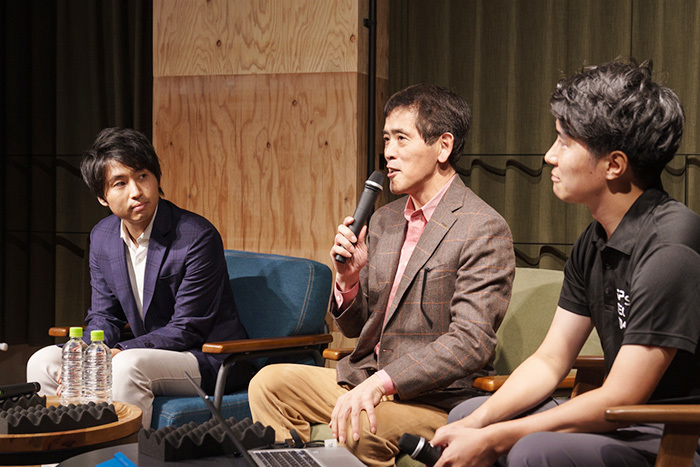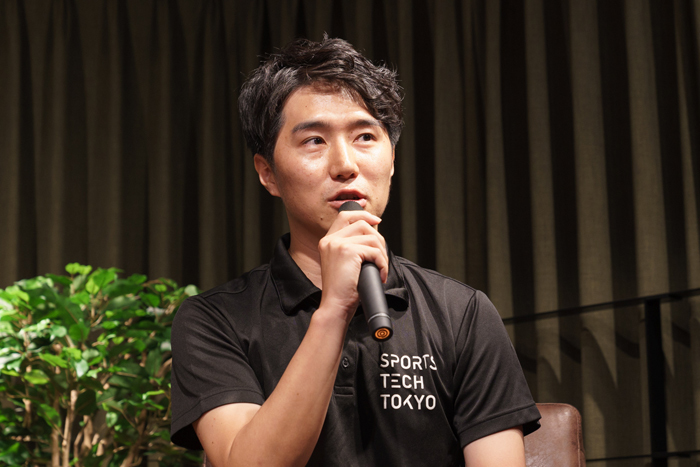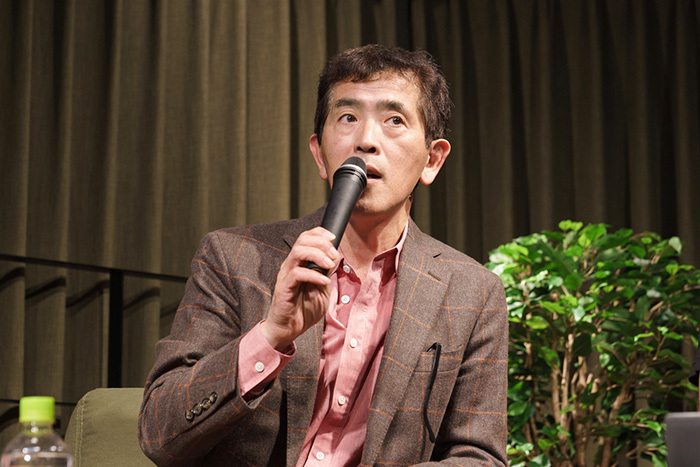What does a "community where business takes off" require?

Kohei Shiraishi
Scrum Ventures

<Table of Contents>
▼SPORTS TECH TOKYO Has a "Business-Oriented Vibe"
▼Three Key Points of a "Community Where Projects Take Off"
▼The Key to Commercialization: "Issue-Driven"
▼Chance Encounters in the Community Lead to Business Opportunities
▼Breaking Through the Sports Industry's Closed Environment
I'm Kohei Shiraishi, part of Dentsu Inc. CDC division. My current focus is business design and supporting business development. Incidentally, I majored in athletic training during my student days.
In my current role as a project member of the global acceleration program " SPORTS TECH TOKYO " (STT), focused on sports, I facilitate business matching between startups and various companies/organizations and drive their commercialization.
STT has held numerous conferences and meetup events to date, and many open innovation initiatives have already materialized in the form of collaborations and business development.
While many such business community matchings often fail to translate into actual business, what makes the STT community different?
We recently invited two guests deeply involved in creating sports business to an STT meetup event. They held a session themed "The Value of Community in the Sports x Tech Field." We reflect on what emerged from their discussions: "What is necessary for a community where business is born?"
SPORTS TECH TOKYO has a distinct "business scent"

Our session featured Shigeo Araki, CEO of Sports Marketing Laboratory (hereafter, SpoLab), and Hironori Inagaki, Attorney at Nishimura & Asahi Law Offices.
Mr. Araki, a key figure in Japan's sports tech scene, held key positions at global tech companies before transitioning to professional baseball, where he implemented various reforms. He continues to develop and operate solutions utilizing ICT technology within the sports industry.
Mr. Inagaki is seconded from Nishimura & Asahi to Pacific League Marketing (PLM). He handles new business development for the Pacific League and sponsorship sales for sports organizations. At STT, he mentors startups, advising them from both legal and business perspectives.
As the sports tech market expands and numerous communities emerge, why are both of them deeply committed to STT? Given limited resources, joining an unfamiliar community can be, to put it bluntly, a "hassle."
In response to my question, Mr. Araki answered, "Because I sense business is about to take off."
"Open innovation is being discussed everywhere in various forms right now, but STT really has that distinct business feel. Why? Because it's a program driven by people with Dentsu Inc.'s accumulated business expertise, marketing acumen, creative sensibility, and strategic insight. They're organically combining these elements and pushing forward with real momentum. It's a space created by people with overwhelming drive to make things happen. You'd be crazy not to use it." (Mr. Araki)
Mr. Inagaki followed, stating, "Trust is crucial in business."
"I handle sponsorship sales for all sports, including baseball, at PLM. I feel daily how incredibly difficult it is to get companies uninterested in sports to take notice. In that regard, the companies participating in STT are ones Dentsu Inc. has already built trust with. Furthermore, their interest in new sports business is a given, making it easier to share our vision. For content holders like us, it's a rational decision not to utilize this platform." (Mr. Inagaki)
When launching STT, we declared upfront, "This program will cover everything from business development support to field testing in sports and societal implementation," and secured the necessary resources. Amidst the buzz around open innovation and platform businesses, we felt "programs that only generate seeds of ideas are largely meaningless (lacking practical effectiveness)."
Of course, "talk is cheap." Turning a vision into a concrete plan and then executing and implementing it requires a significant level of commitment.
This approach may be why participants perceive this as a space that transcends merely merging sports and technology, elevating it into a true "business" opportunity.
Three Key Points of a "Community Where Projects Take Flight"

For STT to develop further, we need to consider "the ideal community structure for projects to take off." Mr. Araki, who has promoted various sports businesses, presented the following three points:
① Decision-makers must be present
"Discussions without decision-makers may be lively at the time, but when you meet next, you end up starting over from scratch. If a chemical reaction occurs within the community, you need someone with the authority to make decisions on the spot and drive the next phase forward with speed," (Mr. Araki)
② Involving business professionals from other industries
"Sports business is built on the multiplication of 'sports × other industries'. While there's often talk about needing sports business talent, it's too vast a field for people within the sports industry to study other industries comprehensively. Instead, having non-sports business professionals learn the essence of sports business is far more efficient and effective for broadening business variations." (Mr. Araki)
③ Communicating the industry's challenges
"To attract business professionals from other industries, the key is to communicate 'challenges'. Lay out the challenges facing the sports industry and what we want to achieve, sharing them openly on the table. Once that's done, we can approach them with 'We can solve this challenge with our company's products or services' , leading to more business-connected matches." (Mr. Araki)
The Key to Monetization is "Issue-Driven"

Mr. Araki cited "technology-first matching" as a reason for the scarcity of successful sports tech cases in Japan.
"There are many cases where the approach is, 'We have this technology; maybe it could be used in some sport.' With this kind of tech-driven approach, you won't create a business that meets the market's or customers' underlying needs. What's crucial is being issue-driven. The need – 'We want to solve this problem' – comes first, and then technology solves it," said Mr. Araki.
Inagaki agrees. He often finds issue-driven approaches crucial in the sports tech field.
"In my role at PLM, I connect tech companies with the Pacific League. With a tech-driven approach, you end up asking, 'This is great tech, but is it really the best solution?' Furthermore, an issue-driven approach allows for a smooth progression to the proof-of-concept phase for implementation. But if the technology comes first and the problem is vague, you can't move forward with the proof or implementation," (Mr. Inagaki)
Responding to this, Mr. Araki stated, "With a tech-driven approach, even if a match is found, it's often a 'nice to have' rather than a 'must have'. It doesn't reach the point of becoming a viable business." He then introduced a solution currently under development at STT as a successful example of an issue-driven approach.
At Araki's Sports Lab, they've been providing free online streaming of Tokyo's Big Six University Baseball games for three years. However, with the proliferation of OTT (Over The Top, meaning streaming services) increasing the volume of sports being streamed, they faced a shortage of play-by-play announcers and struggled with casting.
Consequently, Mr. Araki concluded, "To grow the sports streaming business, we had no choice but to train our own announcers." He launched the "Sports Commentary Academy" in 2017. When recruiting students, however, applicants included not only those aspiring to be broadcasters but also people who simply wanted to talk about the Big Six University Baseball League.
"That's when I realized there's a need to 'talk about' sports, in addition to 'playing,' 'watching,' and 'supporting' them. Some people would even pay to talk about it. So, I thought, let's build a platform where such people can do play-by-play, and began exploring that idea," said Araki.
It was truly a case of "identifying a problem first." At that very moment, STT happened to encounter the American startup "SportsCastr" ( refer to Sports Caster, Part 4 of the series ). It's a platform where users can become sports casters and distribute videos of themselves commentating on sports broadcasts.
"We had originally planned to build our own system, but when Mr. Shiraishi introduced us to SportsCastr, we jumped at the chance. We conducted several proof-of-concept tests together at STT, and we're actually very close to launching it as a service." (Mr. Araki)
A chance encounter in the community leads to business

Let me share another example of a business born from STT.
Mr. Inagaki worked diligently to establish "Ticket Street," a secondary ticket vendor, as the officially recognized secondary distributor for three Pacific League teams (Hokkaido Nippon-Ham Fighters, Chiba Lotte Marines, Orix Buffaloes) as part of his PLM business.
From his perspective as a lawyer, Mr. Inagaki points out that within the sports tech domain, there exist "businesses with promising potential that remain unrealized due to unresolved legal issues."
"Sports betting (gambling on sports), fantasy sports (online games based on real athletes' performance), and secondary ticket distribution. All these are legally conducted in some overseas markets like the US, generating significant revenue. However, in Japan, they are perceived as legally gray or borderline illegal, so commercialization hasn't progressed," says Inagaki.
Mr. Inagaki, who originally focused intensely on secondary ticket distribution as a lawyer, explains that sports business has four main revenue streams: "broadcast rights," "tickets," "sponsorship," and "merchandising." For example, in the U.S., secondary distributors have formed partnerships with MLB to develop massive businesses, but this was not possible in Japan.
"The turning point came with the 'Ticket Resale Prohibition Act,' enacted in June 2019 in anticipation of the Olympics and Paralympics. This law does not completely ban secondary ticket sales. Rather, it can be seen as legislation that clearly distinguishes between 'good' and 'bad' practices in secondary ticket sales, thereby enabling the creation of a legitimate business," (Inagaki)
In other words, the enactment of this law clarified the "proper form of legal secondary ticket distribution."
"At the STT kickoff meeting, I met Mr. Kei Nishiyama, President of Ticket Street. Right then and there, President Nishiyama expressed his desire to 'form a business partnership with the Pacific League,'" (Mr. Inagaki)
The example of Ticket Street's secondary ticket distribution is also issue-driven. It responds to the "potential customer demand" mentioned earlier by Mr. Araki.
Incidentally, at STT, Dentsu Inc. doesn't necessarily meticulously define the purpose for every single business idea that emerges. While we do some traffic control to make business more viable, the strength of this project lies in creating what I call "organized chaos" – a space that is organized yet chaotic ( refer to Part 3 of the series ).
Breaking Through the Sports Industry's Closed Environment
Finally, we asked about future challenges for sports tech. Both speakers noted that the sports business world remains quite closed off.
"There are many people who want to get into sports business, but it's still difficult for newcomers to break in. I myself came to professional baseball from a law firm. Going forward, I think we need to create more accessible entry points for people from industries traditionally unrelated to sports. If we can properly engage the various specialists and business professionals who support Japan's diverse industries within the sports sector, it could lead to much greater development," (Mr. Inagaki)
"The sports industry should increase its value through diversity—how much variation it can incorporate—rather than just collecting many similar pieces. However, many organizations struggle to accept that variation. That's precisely why organizations like PLM, which recognized the value of diversity and accepted Mr. Inagaki, are a perfect fit. I believe this applies to any industry: what matters most now is 'how many people with unique strengths come together to drive innovation.' Unless we steer in that direction, the world of sports won't change either," (Mr. Araki)
Both gentlemen noted that the sports world faces various constraints and preconceived notions, making breakthroughs difficult. We also believe that STT shouldn't just focus on promoting itself; we need to cultivate it as a platform where the sports industry can share its challenges, taking a long-term view.
Please continue to look forward to STT as a place where we can create numerous precedents for commercialization alongside our diverse partners!
Was this article helpful?
Newsletter registration is here
We select and publish important news every day
For inquiries about this article
Back Numbers
Author

Kohei Shiraishi
Scrum Ventures
After working at Nomura Securities, joined Dentsu Inc. Engaged in business design and business development support for a wide range of clients and partners, from national clients to startups. Led the sports-themed acceleration program "SPORTS TECH TOKYO." Left Dentsu Inc. in 2023 and is currently advancing related operations and business development for a sports and entertainment-focused fund at ScrumVentures, a venture capital firm based in Silicon Valley.

